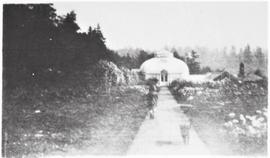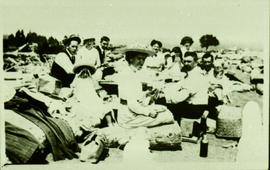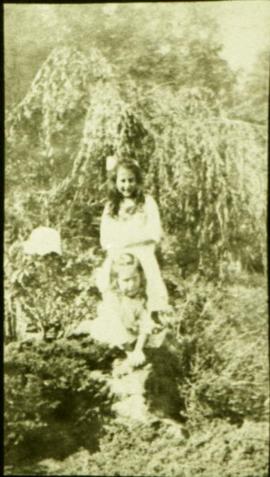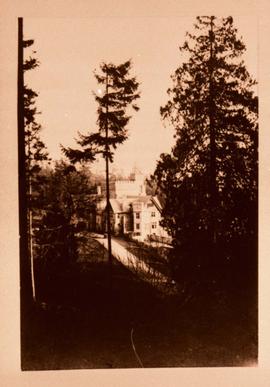The shape of this greenhouse is not the same as the Lord and Burnham greenhouses at Hatley Park and may have been on the estate prior to the improvements made by landscape architects, Brett and Hall from 1912 to 1914. It may also be somewhere other than Hatley Park.
Phillip Francis Hayward and his family lived in the gardener’s cottage on the west side of the walled garden. His youngest daughter, Frances, was born there in 1913. In this image, the children can be seen playing in the front yard of the cottage as a truck is passing by on the road outside the walled garden.
Image shows the west side of the walled garden with the greenhouse and conservatory. Fruit crops are grown either side of the pathway.
This toy car is also visible in the K. McCann fonds, image 1-3-85, where an adult woman is seated in the car in the Italian garden.
The image shows the castle newly completed, although the label is signed by Mrs. Humphreys. Kathleen Dunsmuir married Arthur Selden Humphreys in 1915 so the Christmas card cannot predate 1915.
The header house for the greenhouse complex provided an indoor workspace without taking away from the growing space. The boilers used to heat the greenhouses were kept in the basement of this building.
The greenhouse and conservatory were constructed and installed by the Lord and Burnham Company. The glass house complex had a full time manager and required 60 tons of coal and 200 cords of wood per year to heat. The ornate conservatory had a central dome of about 30 ft square, with two side galleries, each 60 ft long. Flowers were grown inside that were intended for display in the castle and in later years it was also used for food production.
This image shows how the grounds around the greenhouse within the walled garden were also used as a kitchen garden, likely growing such vegetables as cabbages, cauliflower and brussells sprouts.
The greenhouse and conservatory were constructed and installed by the Lord and Burnham Company and they later used the estate installation in their promotional material. The glass house complex had a full time manager and required 60 tons of coal and 200 cords of wood per year to heat. The ornate conservatory pictured had a central dome of about 30 ft square, with two side galleries, each 60 ft long. Flowers were grown inside that were intended for display in the castle and in later years it was also used for food production. According to a former gardener, interviewed in the 1950s, Laura Dunsmuir said that the conservatory was an extravagance in a private garden and that it should be in a public park.
Many Chinese workers were employed in the gardens at Hatley Park and Phillip Francis Hayward supervised several of the men as manager of the greenhouse complex.
The greenhouse and conservatory were constructed and installed by the Lord and Burnham Company as part of the estate development by Boston based landscape architects, Brett and Hall. The glass house complex had a full time manager and required 60 tons of coal and 200 cords of wood per year to heat. The ornate conservatory had a central dome of about 30 ft square, with two side galleries, each 60 ft long. Flowers were grown inside that were intended for display in the castle and in later years it was also used for food production. According to a former gardener, interviewed in the 1950s, Laura Dunsmuir said that the conservatory was an extravagance in a private garden and that it should be in a public park.
The poor quality of the reproduction makes most of the people unidentifiable, however the man on the far left is William Edward John ('Fred') Mann.
Harry Mann was the youngest son of the coachman and friends with Ella Hayward. He is sitting on the railings of a rustic fishing bridge at the north end of the pond in the Japanese garden.
The upper Japanese garden at Hatley Park was designed by Japanese landscape architect Isaburo Kishida. The garden was installed in 1909 and developed by Tadashi Noda from 1913-1927. The bridge seen in this photo is part of the developments made by Tadashi Noda.
Hatley Castle was designed by renowned British Columbia architect Samuel Maclure for James Dunsmuir. Using only the finest materials, builders, stonemasons and detail carpenters only took 18 months to construct the building from 1908 until 1910.
Hatley Castle was designed by renowned British Columbia architect Samuel Maclure for James Dunsmuir. Using only the finest materials, builders, stonemasons and detail carpenters only took 18 months to construct the building from 1908 until 1910. The estate was further developed from 1912-1914 by Boston based landscape architects, Brett and Hall. This included addition of a new entrance on Sooke Road that would bring the visitor down a winding, serpentine road to the main house. This view through the trees was the first glimpse the visitor had of the Dunsmuir's castle.
Hatley Park staff and families are gathered for a picnic, probably at Esquimalt Lagoon beach. Coachman, William Edward John ('Fred') Mann is on the right and Phillip Francis Hayward is on the left holding one of his daughters. At the back of the table is Harry Mann, the youngest son of WEJ and Harriet Mann.
Hatley Park staff and families are gathered for a picnic, probably at Esquimalt Lagoon beach. William Edward John ('Fred') Mann is on the right and Phillip Francis Hayward is on the left holding one of his daughters. At the back of the table is Harry Mann, the youngest son of WEJ and Harriet Mann.















![group of nine adults [Hatley Park staff] and one child at the [Esquimalt Lagoon] beach.](/uploads/r/royal-roads-university-archives/3/6/1/36138b0553941723061c7b93689d58b012853150b67671055a0b501fdb2715f7/025-008_1-01-011_142.jpg)








